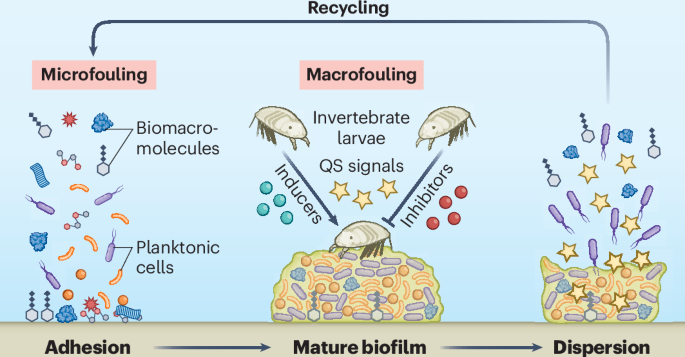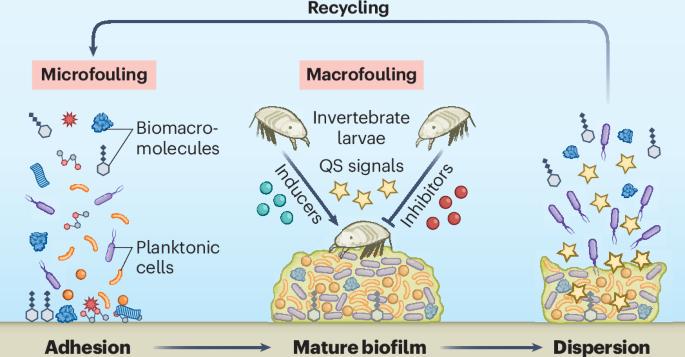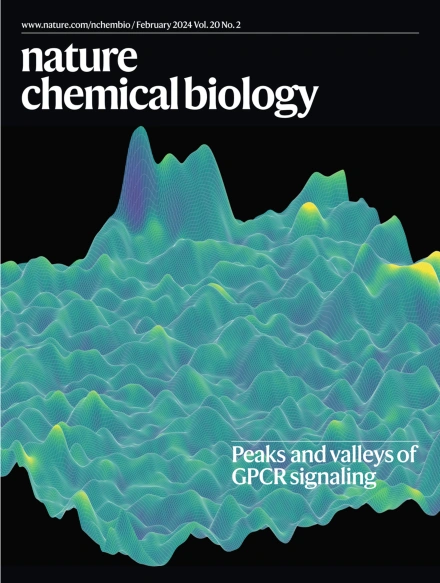生物膜介导的生物污损中的化学信号传递
IF 12.9
1区 生物学
Q1 BIOCHEMISTRY & MOLECULAR BIOLOGY
引用次数: 0
摘要
生物污损是指生物体及其代谢物在水下表面的不良堆积。生物污损始于生物大分子和/或微生物的粘附,随后会形成主要受化学信号(如环状二核苷酸和定量感应分子)调控的生物膜。生物膜通常会释放化学线索,吸引或排斥其他无脊椎幼虫和藻类孢子。因此,利用其中的生化机制是控制生物污损的一个很有前景的途径。在这里,我们将讨论化学信号如何影响模式物种生物膜的形成和分散。我们还研究了如何将其转化为海洋生物污损。我们还讨论了生物膜化学线索对大型污损的诱导和抑制作用。最后,我们概述了有前景的缓解策略,即通过针对化学信号来促进生物膜的分散或抑制生物污损。本文章由计算机程序翻译,如有差异,请以英文原文为准。


Chemical signaling in biofilm-mediated biofouling
Biofouling is the undesirable accumulation of living organisms and their metabolites on submerged surfaces. Biofouling begins with adhesion of biomacromolecules and/or microorganisms and can lead to the subsequent formation of biofilms that are predominantly regulated by chemical signals, such as cyclic dinucleotides and quorum-sensing molecules. Biofilms typically release chemical cues that recruit or repel other invertebrate larvae and algal spores. As such, harnessing the biochemical mechanisms involved is a promising avenue for controlling biofouling. Here, we discuss how chemical signaling affects biofilm formation and dispersion in model species. We also examine how this translates to marine biofouling. Both inductive and inhibitory effects of chemical cues from biofilms on macrofouling are also discussed. Finally, we outline promising mitigation strategies by targeting chemical signaling to foster biofilm dispersion or inhibit biofouling. Biofouling causes a huge economic loss to our society. This Perspective examines the biofouling process from microfouling to macrofouling, discusses a spectrum of chemical signals that induce and inhibit biofouling and argues for potential management by targeting the signaling responsible for biofilm dispersion or biofouling inhibition.
求助全文
通过发布文献求助,成功后即可免费获取论文全文。
去求助
来源期刊

Nature chemical biology
生物-生化与分子生物学
CiteScore
23.90
自引率
1.40%
发文量
238
审稿时长
12 months
期刊介绍:
Nature Chemical Biology stands as an esteemed international monthly journal, offering a prominent platform for the chemical biology community to showcase top-tier original research and commentary. Operating at the crossroads of chemistry, biology, and related disciplines, chemical biology utilizes scientific ideas and approaches to comprehend and manipulate biological systems with molecular precision.
The journal embraces contributions from the growing community of chemical biologists, encompassing insights from chemists applying principles and tools to biological inquiries and biologists striving to comprehend and control molecular-level biological processes. We prioritize studies unveiling significant conceptual or practical advancements in areas where chemistry and biology intersect, emphasizing basic research, especially those reporting novel chemical or biological tools and offering profound molecular-level insights into underlying biological mechanisms.
Nature Chemical Biology also welcomes manuscripts describing applied molecular studies at the chemistry-biology interface due to the broad utility of chemical biology approaches in manipulating or engineering biological systems. Irrespective of scientific focus, we actively seek submissions that creatively blend chemistry and biology, particularly those providing substantial conceptual or methodological breakthroughs with the potential to open innovative research avenues. The journal maintains a robust and impartial review process, emphasizing thorough chemical and biological characterization.
 求助内容:
求助内容: 应助结果提醒方式:
应助结果提醒方式:


